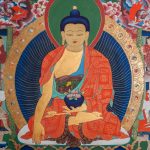Buddhism
Buddhism is a collection of methods for transforming disturbing emotions into clarity and wisdom. These methods have been tested, refined and proven over thousands of years, and continue to benefit hundreds of millions of people today. Buddhism starts from the realisation of impermanence – that the things we take for granted, that we get upset about, that we spend all our time and energy on, all have a beginning, a middle, and an end. Our body, our thoughts and feelings, are all equally impermanent. But Buddhism is not nihilistic. There is something that is constant, that is aware of all the phenomena that come and go. This is our mind itself. Our capacity to be aware.
Ordinarily we are hardly aware of this fundamental awareness, watching instead the objects of awareness in an endless play. But we can get to know our own mind, through Buddhist meditation. Becoming aware of the timeless nature of midind itself leads to enlightenment. Enlightenment is the full development of mind. The complete perfection of all of our innate potential. Here, all illusion falls away, and everything is seen clearly in itself and as part of the whole. Disturbing emotions do not drive us any longer – we see them as the free play of mind. An enlightened person (or a liberated one, who has attained a high level on the way) is always joyful, kind, and useful.
This is the state that the historical Buddha reached 2,500 years ago, and it is the goal for Buddhists worldwide today. To get to this high state, we start where we are. We take responsibility for our own lives through understanding karma, or cause and effect, and we learn how to change our karma – our habits and circumstances – in a more useful direction. We develop compassion, seeing that everyone is basically like us, in that they too search for happiness, more or less successfully. And we practice Buddhist meditation, in order to develop ourselves as fast as possible so that we can be most useful for everyone else. This is the function of the Buddhist centre – to give access to authentic Buddhist meditations and teachings to those who are interested in using them.
Tibetan Buddhism
The Buddha taught many different kinds of people, and his teachings were later grouped into different schools, which give emphasis to different aspects. All authentic schools of Buddhism are good. What is today called the Theravada is well known for teachings such as the Four Noble Truths and the Eightfold Path. Their goal is personal liberation. Mahayana (Great Way) Buddhism, which includes much of Japanese and Chinese Buddhism, stresses the goal of becoming enlightened for the benefit of all. And Vajrayana (Diamond Way) Buddhism includes the teachings of the first two levels, and adds the view that everyone is already enlightened Buddhas who just don’t realise it yet.
When Buddhism came over the Himalayas to Tibet, all levels of the Buddha’s teachings were transmitted. In the remote kingdoms of Tibet they were kept alive, as many transmissions were extinguished in other countries over the centuries. And beginning in the 1950s, after the brutal Chinese invasion, Tibetan Buddhism began to leave Tibet and take root all around the world. The best known Tibetan Buddhist teacher is probably the Dalai Lama, who belongs to the Gelug school. Our Diamond Way school belongs to the Karma Kagyu lineage, whose head is the Karmapa. The Karmapas predate the Dalai Lamas by several hundred years, being the oldest reincarnate lineage in Tibet.
To learn more about Buddhism, Tibetan Buddhism, and how we practice, come along to one of our introductory evenings.


